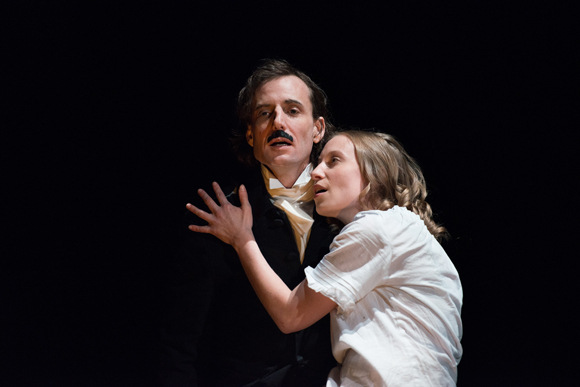Red-Eye to Havre de Grace

(© Johanna Austin)
Someone is following you. You're haunted by the ghost of a lost love. You're drawn into a tight space and buried alive. Nineteenth-century author Edgar Allan Poe explored all of these scenarios and more in his poems and short stories. Almost two centuries later, his nightmarish visions are still the basis of so much American horror. Director Thaddeus Phillips and his troupe of performers use many of Poe's own words and themes to tell the frightening story of the poet's final days in Red-Eye to Havre de Grace at New York Theatre Workshop. It's a sensory overload that seduces us into Poe's world and then, like Montresor in The Cask of Amontillado, traps us inside for a terrifying 90 minutes.
The show starts mildly enough. Steve (Jeremy Wilhelm), a park ranger from the Edgar Allan Poe National Historic Site in Philadelphia, gives us a few facts about Poe to consider before the curtain rises: Poe (Ean Sheehy) spent five years watching his wife, Virginia (Alessandra L. Larson), die of tuberculosis. Virginia first realized she was dying when a blood vessel burst in her throat while she was playing the piano. After her death, Poe continued to live with his mother-in-law ("Muddy"), with whom he regularly corresponded on his trips to literary societies from D.C. to Boston, what is now commonly referred to as the "Acela Corridor."
Much of the action takes place on trains and in train stations, as Poe travels between New York, Philadelphia, and Baltimore. He's in a constant state of anxiety, and he worries that he's being followed. Ranger Steve plays practically every other character in the show, from train conductors to Dr. John Sartain, in whose Philadelphia home Poe seeks refuge when he's convinced someone is trying to kill him. Composer David Wilhelm (brother of Jeremy) pumps the pedals of a dissected upright piano during the travel scenes, mimicking the chugging of the train as well as the rapid beating of Poe's heart.
The Wilhelms' music is crucial in creating an atmosphere of terror: The actors strike, pluck, and bow the piano strings, refusing to rely on the keys to sustain a sufficient level of creepiness. It's amazing what comes out of this tortured workhorse of an instrument. At one point, Poe and Virginia sit at opposite ends of a long white tablecloth, drinking tea. David Wilhelm plays a somber nocturne on the piano while Jeremy Wilhelm, who has a resonant and colorful operatic voice, sings along with the French translation to "Annabelle Lee." It's a scene straight out of a particularly arty haunted house.
As Virginia, the unbelievably agile Larson is a constant spectral presence throughout the show. She crawls around Poe's back and onto the furniture like a naughty kitten, exuding the kind of playfulness one might expect from a considerably younger spouse. (Virginia was 13 when she married a 27-year-old Poe.) A segment in which she dances flamenco while on stilts is unforgettable, both for its novelty and physical difficulty. Virginia never speaks, adding to her otherworldliness. Larson is so expressive in her movement that words would feel superfluous.
Sheehy does the heavy lifting with the text, reciting many of Poe's real letters and poems with an obsolete and grandiose American diction. Whether he's lecturing or doing battle with his demons, every word is crystal clear. Sheehy seems possessed by the spirit of Poe, a man with an infinite imagination, constantly thwarted by the limitations of his quotidian surroundings.
Phillips creates haunting and ultra-specific stage pictures using the most common of props, costumes, and set pieces: A table doubles as a door, a train compartment, and a hotel hallway. Drew Billiau casts dark and foreboding shadows across the stage with a simple assortment of practical and stage lights. Sound designer Robert Kaplowitz heightens and accents the tiniest sounds, giving the feeling that one is inside a film or video game. Everything about this production is inventive, visually arresting, and utterly memorable. Who needs big-budget effects when you have a great story and a keen understanding of how to manipulate the senses?
Without saying as much, Red-Eye to Havre de Grace makes a pretty compelling case that Poe was a paranoid schizophrenic in a time when little was known about mental illness, that his Gothic genius was as much a product of his hallucinations as his ability to turn a phrase. While such autobiographical literary analysis has its limitations, the mysterious circumstances surrounding the author's death lend that notion some credence. Thankfully, Phillips and the Wilhelms maintain some of that mystery for you to contemplate long after you've left the theater.










